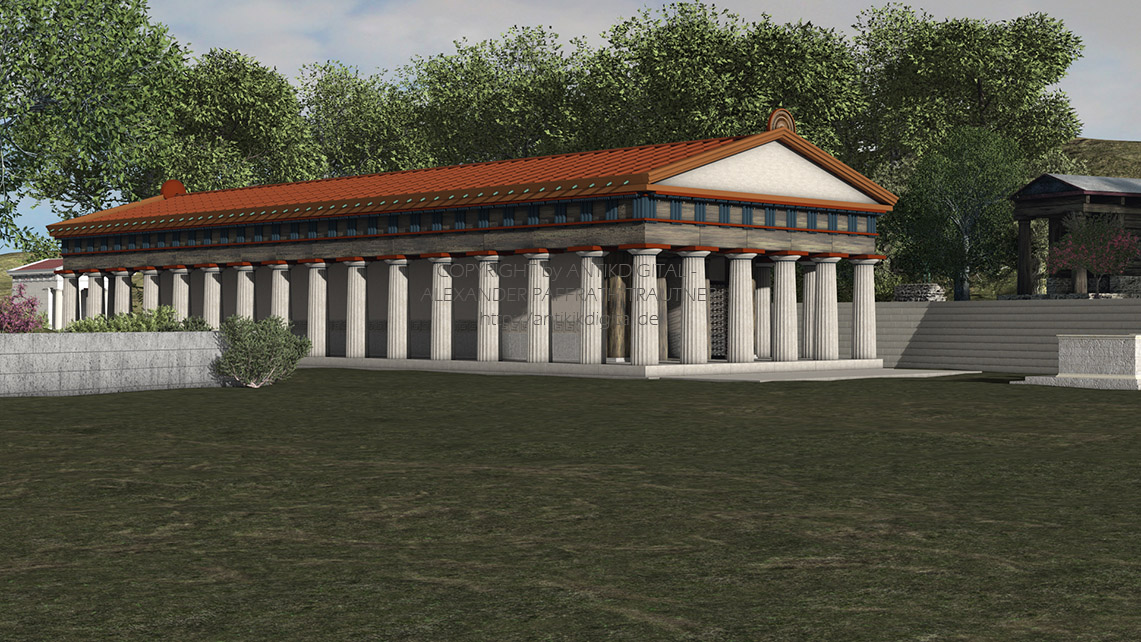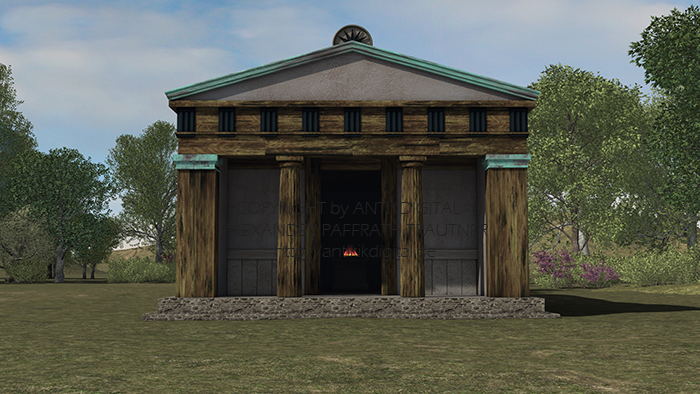 |
|||||
|
|
Das Heraion Da der Baubeginn für den kultischen Vorgängerbau des Heraions um die Jahrtausendwende v. Chr. angesetzt wird, ist die Schatzhausterrasse direkt neben dem archaischen Tempel damals noch nicht vorauszusetzen. Der Abhang des Gaion, westlicher Ausläufer des Kronoshügels, war damals noch geologischer Bestandteil der Altis(wiese).Südlich vom Gaion viel das Tarrain bis zum Alphaios sanft ab und bildete eine zu diesem Fluß gehörende Flußauenlandschaft. Da das Gelände auch vom Fluß Kladeos im Westen in Richtung Osten abfiel ergaben sich für die Architekten des Heiligtums ständige Herausforderungen bei der Fundamentierung der Bauten und bei ihrer Trockenlegung.Bei der Fundierug des Urtempels an Stelle des Heraions war das Gelände der Altis noch nicht planiert und man hatte offensichtlich Schwierigkeiten damit, aufgrund auch der Bodenbeschaffenheiten den Tempel statisch zu sichern. Das geht aus den Ausführungen des Archäologen Mallwitz hervor. Er schreibt dazu: "... Er (der Tempel) ist nicht nur der älteste Peripteraltempel das Heiligtums, er ist auch Nachfolger einer unter ihm liegenden, älteren Kultstätte, ohne seine unfreie Lage dicht am Fuße des Gaios nicht zu verstehen wäre. Den Bauleuten wurde als Bauplatz eine nach Südwesten sich neigende Ebene angewiesen." Das Heraion wurde sicher in mehreren Etappen erbaut, die nicht nur kultischen Konditionen folgten, sondern auch dem sich ändernden architektonischen Geschmack. Man geht wohl nicht fehl, sich den unmittelbar vorausgegangenen Bau als Antentempel vorzustellen. Dies verrät unter anderem der Grundriß und die Materialverwendung bei der Cella des späteren Ringhallentempels.
Diese Rekonstruktion (2) von A. Paffrath
Trautner zeigt den Vorgängerbau des Heraions als Antentempel, das
heißt ohne Ringhalle. Sie wurde aus der Cella des rekonstruierten
Heraions entwickelt und demonstriert damit, dass die Cella und das
vorausgegangene Ur-Heraion identisch gewesen sein können. There the area also from River Kladeos in the west in the direction of the east dropped arose for the architects of the sanctum constant challenges with the Fundamentierung of the constructions and by her dry lapping. With that Fundierug of the old temple at place of the Heraions was the area of her Altis yet does not level and one had obviously difficulties with it, on account of the also surface conditions the temple statically to protect. This goes from the implementation of the archeologist Mallwitz out. He writes in addition: "... He (of the temples) is not only the oldest Peripteraltempel the sanctum, he is also Successor of an older cult site lying under him, without his not free situation close at the foot of the Gaios not to understand would be. To the construction workers one became as a construction site after Southwest bending level instructed. " The Heraion was certainly built in several stages which followed not only ritual conditions, but also to the changing architectural taste. One probably does not go is absent to fancy itself the immediately preceding construction as an Antentempel. This if the plan and the material use betrays, among the rest, with the cella of the later ring hall temple. The reconstruction (2) on top from A.
Paffrath Trautner shows the predecessor's construction of the Heraions
as an Antentempel, that is without ring hall. It was developed from the
cella of the reconstructed Heraions and demonstrates with the fact that
the cella and the preceding Ur-Heraion can have been identical. Là le terrain aussi de La rivière Kladeos à l'ouest en direction de l'est tombait résultaient pour les architectes du sanctuaire les défis continuels au Fundamentierung des constructions et lors de sa pose sèche. Chez elle Fundierug du prototemple au lieu de Heraions était le terrain d'elle Altis n'aplanit pas encore et on avait évidemment des difficultés avec cela, en raison de Bodenbeschaffenheiten aussi le temple statiquement à sont aux aguets. Cela va des exécutions de l'archéologue Mallwitz en avant. Il écrit en plus : "... Il (des temples) n'est pas seulement le Peripteraltempel le plus âgé le sanctuaire, il est aussi Successeur d'un lieu de culte plus âgé, se trouvant sous lui, sans sa situation dépendante près au pied de Gaios non à comprennent serait. Aux gens de construction, l'un devenait comme le terrain à bâtir après Sud-ouest le niveau s'inclinant indiqué. " L'Heraion était certainement construit par plusieurs étapes qui suivaient non seulement les conditions cultuelles, mais encore au goût architectural changeant. Bien, on ne va pas manque de s'imaginer la construction directement allée comme Antentempel. Cela si le plan et l'application de matériel trahit entre autres à Cella de temple d'halls d'anneau plus tardif.La reconstruction (2) en haut d'A. Paffrath Trautner montre la construction de prédécesseur de Heraions comme Antentempel, cela s'appelle sans hall d'anneau. Elle était développée de Cella de Heraions reconstitué et manifeste que Cella et l'Ur-Heraion allé peuvent avoir été identiques. |
| copyright: www.antikdigital.de | |